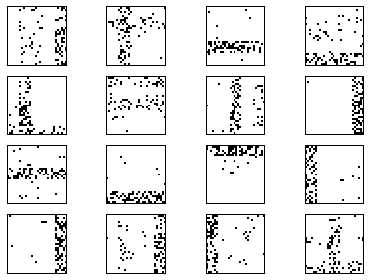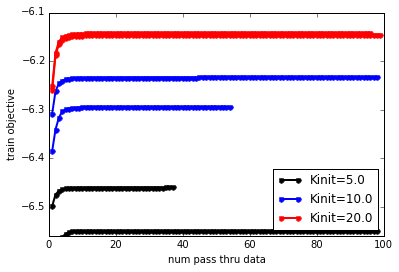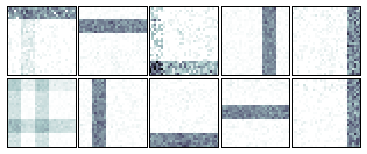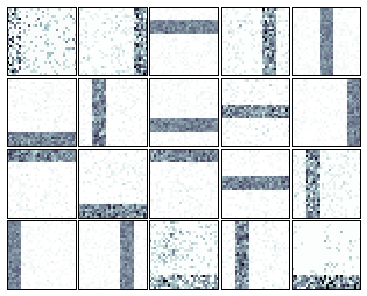Wiki
Clone wikibnpy-dev / demos / BarsToyData-FiniteTopicModel-Variational
Learning an LDA topic model on Toy Bars Data with variational inference
Goal
This demo walks you through using bnpy from within python to train a Latent Dirichlet Allocation (LDA) topic model on bag-of-words data. We'll use the full-dataset variational inference algorithm.
We can use the following import statements to load bnpy.
import bnpy from matplotlib import pylab %pylab inline imshowArgs = dict(interpolation='nearest', cmap='bone_r', vmin=0.0, vmax=10./900, )
Populating the interactive namespace from numpy and matplotlib
Toy dataset : BarsK10V900
We'll use a simple "toy bars" dataset called BarsK10V900, generated from the LDA topic model.
Our intended task here is to assign exactly one topic to every token. The data was generated this way.
Be aware that this is different than assigning a single cluster/topic to the entire document.
import BarsK10V900 Data = BarsK10V900.get_data(nDocTotal=1000, nWordsPerDoc=100) Data.name = 'BarsK10V900'
First, we can visualize the 10 "true" bar topics. Each one is a distribution over 900 vocabulary "words", which are represented here as individual pixels in a 30x30 image.
bnpy.viz.BarsViz.showTopicsAsSquareImages(BarsK10V900.Defaults['topics'], **imshowArgs);

Next, we can visualize some example documents. Here are 16 documents
bnpy.viz.BarsViz.plotExampleBarsDocs(Data, nDocToPlot=16, **imshowArgs);

Important keyword options for topic models
--K
The initial number of topics (aka clusters) is determined by this integer. For finite models like LDA, once this is set, for the rest of the algorithm we will represent exactly this many topics in memory. We cannot add more, or remove any. Some topic's frequency parameters may be pushed to zero, but we will still represent them in the computer.
--initname
This string specifies the initialization procedure for the topic-word parameters. Here are the options
* kmeansplusplus [Recommended]
Runs kmeans on the empirical document word-count vectors, using the specified number of clusters \(K\).
* randexamples [Default]
Selects \(K\) documents at random without replacement. Can be bad because it does not
* randomlikewang
Draws each topic-word variational parameter vector \(\tau\) as a Gamma random variable. This is the same procedure used in Wang et al.'s original Python code for HDP topic models.
--alpha
This positive scalar controls the sparsity of the Dirichlet prior on the document-topic assignments.
Set this value smaller (like 0.1 or smaller) to encourage more sparsity in these distributions.
Setting it large (like 10 or 100) will cause all the documents to use all the topics uniformly, which is bad.
--nCoordAscentItersLP
This integer specifies how long to run the local "E" step algorithm, which alternately updates free variational parameters for (1) every token in the document, and (2) the document-specific topic distribution.
Larger values will let the algorithm converge more, but at the cost of more computation. Usually setting this to 10 is too small, while 200 would maybe be too large unless there are many many topics.
--convThrLP
The local "E" step is run at each document, alternating the two steps above until the estimated document-topic counts for the document \([N_{d1} \ldots N_{dk} \ldots N_{dK}]\). We halt the iterations if all values in this vector change by less than convThrLP.
This value defaults to 0.01, which should be fine for most purposes.
Running inference with bnpy
We'll now fit a finite topic model (LDA) with a multinomial likelihood, using standard variational inference (specified by the VB keyword option).
We'll look at several possible initial numbers of clusters.
5 initial clusters, repeated for 2 trials
hmodel, RInfo = bnpy.run(Data, 'FiniteTopicModel', 'Mult', 'VB', K=5, alpha=0.1, lam=0.1, initname='kmeansplusplus', nLap=500, printEvery=25, nCoordAscentItersLP=25, nTask=2, jobname='demobarsVB-Kinit=5-kmeans')
Toy Bars Data with 10 true topics. Each doc uses 1-3 bars.
size: 1000 units (documents)
vocab size: 900
min 5% 50% 95% max
68 76 85 92 99 nUniqueTokensPerDoc
100 100 100 100 100 nTotalTokensPerDoc
Hist of word_count across tokens
1 2 3 <10 <100 >=100
0.84 0.14 0.02 200 0 0
Hist of unique docs per word type
<1 <10 <100 <0.20 <0.50 >=0.50
0 0 0.75 0.25 0 0
Allocation Model: Finite LDA model with K=5 comps. alpha=0.10
Obs. Data Model: Multinomial over finite vocabulary.
Obs. Data Prior: Dirichlet over finite vocabulary
lam = [ 0.1 0.1] ...
Learn Alg: VB
Trial 1/2 | alg. seed: 2497280 | data order seed: 8541952
savepath: /results/BarsK10V900/demobarsVB-Kinit=5-kmeans/1
1/500 after 1 sec. | K 5 | ev -6.497725357e+00 |
2/500 after 1 sec. | K 5 | ev -6.474361847e+00 | Ndiff 256.402
25/500 after 3 sec. | K 5 | ev -6.459785851e+00 | Ndiff 0.705
37/500 after 5 sec. | K 5 | ev -6.459734310e+00 | Ndiff 0.048
... done. converged.
Trial 2/2 | alg. seed: 1128064 | data order seed: 7673856
savepath: /results/BarsK10V900/demobarsVB-Kinit=5-kmeans/2
1/500 after 0 sec. | K 5 | ev -6.605946952e+00 |
2/500 after 1 sec. | K 5 | ev -6.580567563e+00 | Ndiff 1810.242
25/500 after 4 sec. | K 5 | ev -6.548944331e+00 | Ndiff 1.797
50/500 after 6 sec. | K 5 | ev -6.548918037e+00 | Ndiff 0.192
75/500 after 8 sec. | K 5 | ev -6.548903603e+00 | Ndiff 0.164
98/500 after 10 sec. | K 5 | ev -6.548881828e+00 | Ndiff 0.013
... done. converged.
10 initial clusters, repeated for 2 trials
hmodel, RInfo = bnpy.run(Data, 'FiniteTopicModel', 'Mult', 'VB', K=10, alpha=0.1, lam=0.1, initname='kmeansplusplus', nLap=500, printEvery=25, nCoordAscentItersLP=25, nTask=2, jobname='demobarsVB-Kinit=10-kmeans')
Toy Bars Data with 10 true topics. Each doc uses 1-3 bars.
size: 1000 units (documents)
vocab size: 900
min 5% 50% 95% max
68 76 85 92 99 nUniqueTokensPerDoc
100 100 100 100 100 nTotalTokensPerDoc
Hist of word_count across tokens
1 2 3 <10 <100 >=100
0.84 0.14 0.02 200 0 0
Hist of unique docs per word type
<1 <10 <100 <0.20 <0.50 >=0.50
0 0 0.75 0.25 0 0
Allocation Model: Finite LDA model with K=10 comps. alpha=0.10
Obs. Data Model: Multinomial over finite vocabulary.
Obs. Data Prior: Dirichlet over finite vocabulary
lam = [ 0.1 0.1] ...
Learn Alg: VB
Trial 1/2 | alg. seed: 2497280 | data order seed: 8541952
savepath: /results/BarsK10V900/demobarsVB-Kinit=10-kmeans/1
1/500 after 1 sec. | K 10 | ev -6.384955954e+00 |
2/500 after 1 sec. | K 10 | ev -6.340769182e+00 | Ndiff 487.173
25/500 after 5 sec. | K 10 | ev -6.294641929e+00 | Ndiff 2.642
50/500 after 8 sec. | K 10 | ev -6.294527751e+00 | Ndiff 0.117
54/500 after 9 sec. | K 10 | ev -6.294523143e+00 | Ndiff 0.049
... done. converged.
Trial 2/2 | alg. seed: 1128064 | data order seed: 7673856
savepath: /results/BarsK10V900/demobarsVB-Kinit=10-kmeans/2
1/500 after 1 sec. | K 10 | ev -6.308175604e+00 |
2/500 after 1 sec. | K 10 | ev -6.262134141e+00 | Ndiff 467.564
25/500 after 5 sec. | K 10 | ev -6.234179645e+00 | Ndiff 2.107
50/500 after 8 sec. | K 10 | ev -6.234039377e+00 | Ndiff 0.527
75/500 after 11 sec. | K 10 | ev -6.234010173e+00 | Ndiff 0.155
98/500 after 14 sec. | K 10 | ev -6.233997917e+00 | Ndiff 0.044
... done. converged.
20 initial clusters, repeated for 2 trials
hmodel, RInfo = bnpy.run(Data, 'FiniteTopicModel', 'Mult', 'VB', K=20, alpha=0.1, lam=0.1, initname='kmeansplusplus', nLap=500, printEvery=25, nCoordAscentItersLP=25, nTask=2, jobname='demobarsVB-Kinit=20-kmeans')
Toy Bars Data with 10 true topics. Each doc uses 1-3 bars.
size: 1000 units (documents)
vocab size: 900
min 5% 50% 95% max
68 76 85 92 99 nUniqueTokensPerDoc
100 100 100 100 100 nTotalTokensPerDoc
Hist of word_count across tokens
1 2 3 <10 <100 >=100
0.84 0.14 0.02 200 0 0
Hist of unique docs per word type
<1 <10 <100 <0.20 <0.50 >=0.50
0 0 0.75 0.25 0 0
Allocation Model: Finite LDA model with K=20 comps. alpha=0.10
Obs. Data Model: Multinomial over finite vocabulary.
Obs. Data Prior: Dirichlet over finite vocabulary
lam = [ 0.1 0.1] ...
Learn Alg: VB
Trial 1/2 | alg. seed: 2497280 | data order seed: 8541952
savepath: /results/BarsK10V900/demobarsVB-Kinit=20-kmeans/1
1/500 after 1 sec. | K 20 | ev -6.259942731e+00 |
2/500 after 1 sec. | K 20 | ev -6.188580434e+00 | Ndiff 553.015
25/500 after 7 sec. | K 20 | ev -6.146453495e+00 | Ndiff 4.339
50/500 after 11 sec. | K 20 | ev -6.146234090e+00 | Ndiff 0.115
75/500 after 16 sec. | K 20 | ev -6.146224009e+00 | Ndiff 0.073
99/500 after 20 sec. | K 20 | ev -6.146212419e+00 | Ndiff 0.049
... done. converged.
Trial 2/2 | alg. seed: 1128064 | data order seed: 7673856
savepath: /results/BarsK10V900/demobarsVB-Kinit=20-kmeans/2
1/500 after 1 sec. | K 20 | ev -6.251949641e+00 |
2/500 after 1 sec. | K 20 | ev -6.183576703e+00 | Ndiff 719.873
25/500 after 7 sec. | K 20 | ev -6.142806661e+00 | Ndiff 5.266
50/500 after 11 sec. | K 20 | ev -6.142594683e+00 | Ndiff 0.627
75/500 after 16 sec. | K 20 | ev -6.142519221e+00 | Ndiff 0.359
96/500 after 19 sec. | K 20 | ev -6.142512753e+00 | Ndiff 0.049
... done. converged.
Compare trace plots of the objective over time.
Here, we plot the log evidence (sometimes called the evidence lower bound or ELBO). Here, larger objective scores indicate better model quality.
from matplotlib import pylab %pylab inline bnpy.viz.PlotELBO.plotJobsThatMatchKeywords('BarsK10V900/demobarsVB-*'); pylab.legend(loc='lower right');
Populating the interactive namespace from numpy and matplotlib

Conclusion: The initial number of topics matters! If we have too few topics, we cannot represent all the 10 true bars well, and the performance really suffers.
Compare the learned topic-word parameters at different values of K
We can use the plotCompsForTask function included in the visualization tools of bnpy to show the learned topic-word parameters.
Final learned clusters with \(K=5\) topics
bnpy.viz.PlotComps.plotCompsForTask('BarsK10V900/demobarsVB-Kinit=5-kmeans/1/', **imshowArgs)

** Conclusion:** This run discovers the 10 ideal bars topics.
Final learned clusters with \(K=10\) topics
bnpy.viz.PlotComps.plotCompsForTask('BarsK10V900/demobarsVB-Kinit=10-kmeans/1/', **imshowArgs)

Remarks: We've found some of the true topics, but other topics (like lower left) are blends of several bars, while others (far right) are redundant copies.
Final learned clusters with \(K=20\) topics
bnpy.viz.PlotComps.plotCompsForTask('BarsK10V900/demobarsVB-Kinit=20-kmeans/1/', **imshowArgs)

Remarks: We've found all 10 true topics, plus some extra "junk" or redundant topics.
Updated